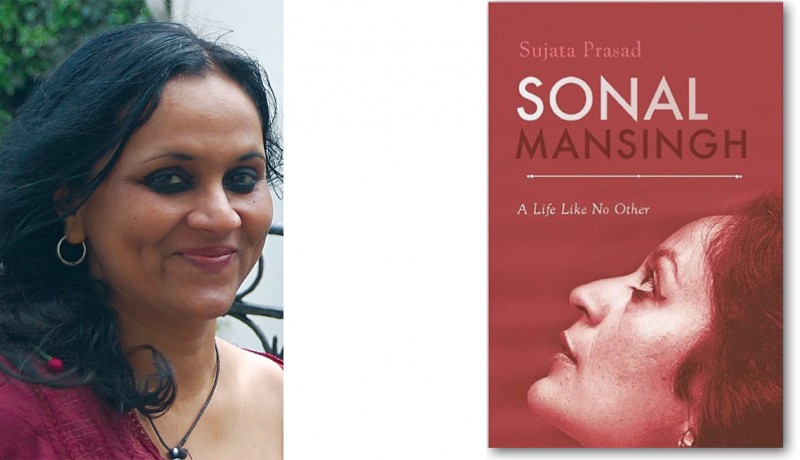
Etcetera

Classical arts are a part of my DNA,” says bureaucrat-turned-author Sujata Prasad, whose recent book Sonal Mansingh: A Life Like No Other (Penguin; ₹ 599; 220 pages) explores the life and times of the celebrated dancer. Substantiated with significant research encompassing classical mythology, colonial studies, dance history, philosophy and classical literature, the book portrays Mansingh’s illustrious career and personal journey with authenticity. The highlight, though, is the voice of the artist. Mansingh’s candour, as evident in one of her responses, is refreshing: “Just some pre-pubescent crushes when I was aching to grow, and some innocent kissing and canoodling as a teenager. But yes, I think I was a little in love with my German professor, in college. I now suspect that one of the reasons I decided to study German was his good looks and dashing style.”
A student of history at Delhi University’s St Stephen’s College, Prasad equipped herself with a degree in sociology from Jawaharlal Nehru University before embarking on a career in the Indian Civil Services. However, her interest in the classical arts, in which she had formal training, did not wane. “Our home was resonant with a cacophony of colours and shapes that stirred my aesthetic emotions,” says the 59 year-old.
As a biographer whose subject deals in extremes, Prasad has been successful in sifting trivia from worthwhile information. Prasad also works with the marginalised through different platforms and has been instrumental in creating sale hubs for folk artisans and weavers from Bihar, a cause close to her heart. She has co-authored a book on health security, a novella for children titled Bruno, My Brother, and edited a journal on public policy besides publishing research papers on different aspects of gender, public health, economic development and the performing arts. In an interview to Suparna-Saraswati Puri, the Delhi-based author talks about her book, which attempts to understand the artist behind the persona and document the contemporary history of Indian classical arts.
EXCERPTS FROM AN INTERVIEW
How did you arrive at the title?
This book is a no-holds-barred account of an extraordinary life. Truly, a life like no other. I did not decide the title; the title manifested itself after we walked down 10 or 20 years of her memories and worked as a metaphor at different levels.
In an interview you spoke of “Sonal’s art being driven by her mind.” Can you elaborate?
Yes, she has an intellectual approach that is not very commonly seen. She has always questioned the notion that performing arts leaves one a little apolitical, a little disengaged. Her choreographies use the leitmotif in historical, classical texts to explore contemporary meanings. This is done very creatively, without undermining traditional dance aesthetics. She has added the naatya katha to her oeuvre, using its unique narrative to engage with social, environmental and gender issues. Her narratives are not set in stone. Every katha seems to undergo a medical makeover, unshackling itself from its past rendition. She engages, provokes, and plays mind games, never letting the audience off the hook.
Did you face any difficulties while working on the book?
I faced several challenges. I was working full time, travelling for brow-furrowing board and other meetings, struggling with my social and personal commitments and several disparate looming deadlines. I was also trying to weather the storm that enveloped me when my parents-in-law and father died in quick succession during this period.
In retrospect, what is the most satisfying aspect of doing the book?
While doing the book I met my subject for several conversations and abstract ruminations. Getting into the interior of a thought or an idea gave me a real high. And then there were moments of epiphany when I escaped from my own tumultuous life into hers. Through all of this, calibrating the emotional arc of her story was one of my biggest challenges and remains the most satisfying aspect of doing the book. She was a dream interviewee—charming, irreverent, outspoken and cocky.
How do you multitask as a bureaucrat, householder, art enthusiast and author?
I enjoy juggling different commitments and setting myself new and somewhat audacious goals! I have a very supportive partner who is also a bureaucrat, author, musician and filmmaker. We have absolutely no time for trivia!
How do you spend your free time?
I don’t get much free time, but when I do I love hanging out with my dogs. I also enjoy coffee-crawling with friends and dabbling in music, dance, theatre and cinema.
Are you planning another book in the near future?
Oh yes, I can see the kernel of an extraordinary idea taking root but it would be a bit premature to talk about it. I am also annotating and, in parts, co-authoring a biography of Jayaprakash Narayan written by my father. This was his last work and, given his long association with Jayaprakash Narayan, his most precious. I am trying to handle the text delicately, reconnecting with my father in ways more than one. I am stupefied by his intellectual energy, and the piercing acuity with which he has written it.
Photo: Tripurari Sharan Featured in Harmony — Celebrate Age Magazine October 2017
you may also like to read
-
Cracking the longevity code
Small yet impactful choices can be game-changers, writes Srirekha Pillai At 102, there’s no stopping Chandigarh-based Man Kaur, the world’s….
-
Home, not alone
While a regulatory framework is vital for senior-care facilities, the need of the hour is to develop an ecosystem to….
-
Birthday Girl
Published in a special edition to honour Japanese master storyteller Haruki Murakami’s 70th birthday, Birthday Girl (Penguin; Rs 100; 42….
-
A huge treat for music lovers
Published as the revised and updated second edition, Incomparable Sachin Dev Burman (Blue Pencil; Rs. 599; 470 pages) the authoritative….







